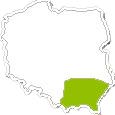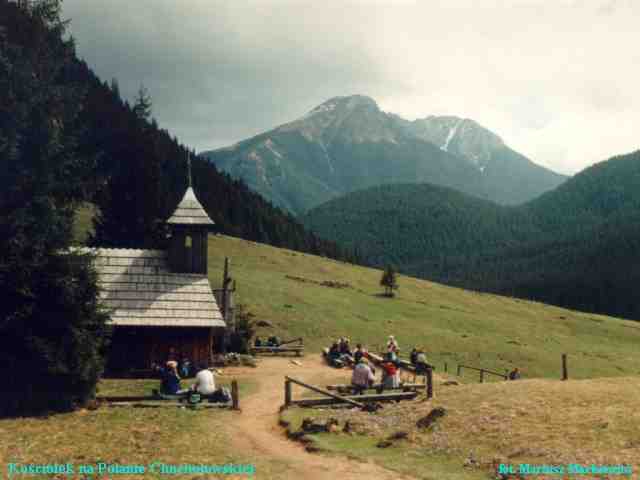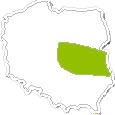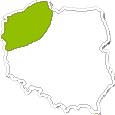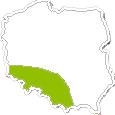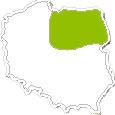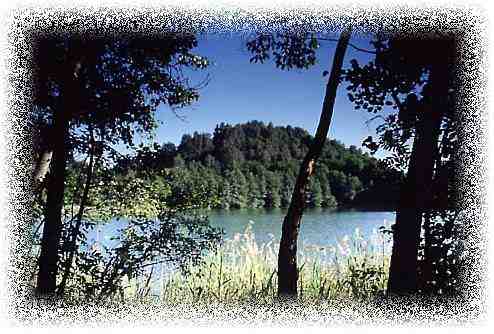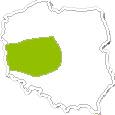The regions of Poland
Malopolska Region (Little Poland)
Possibly in name, but certainly not in
size nor significance, this region of
Poland formed the southern half of the
initial nation formed in the 10th century
by Mieszko I.
Using semantics to
establish political dominance, Mieszko
took the name 'Great Poland' and
relegated 'Malopolska' to his
Vistulanian allies. 70 years later, the region gained power
when the capital was moved to Krakow and from that
springboard developed into what some consider the heart of
Poland.
Strengthening that claim is the multi-besieged but
never-taken Jasna Gora monastery in Czestochowa, home
to the immortal Queen of Poland, the 'Black Madonna'. The
spiritual 'king' of Poland, Pope John Paul II, grew up in
Wadowice, and eventually served as archbishop in Krakow
before his election in 1978. This region is also dotted with
wooden churches built by the Lemk, an ethnic minority
common to the Beskidy Mountains. These peaks are joined
by the limestone-ranged Pieniny and the alpine-like Tatra
Mountains, which are best enjoyed from Zakopane. The
Tatra draw the most tourists, but the Pieniny offer wild
rafting down the Dunajec gorge in May through October
which is well worth the wetting. If spas are your weakness,
then visit the many nestled in the Beskidy in Krynica, Rytro,
or Muszyna. In general, these still-pristine Carpathian peaks
provide an excellent setting for myriad activities, be it
horseback riding, hiking, biking, skiing, bird-watching, or
whatever else suits your nature-loving fancy.
The Tatra Mountains
If architecture is of interest to
you, Malopolska includes not
only the renowned beauty of
Krakow, but also that of
Kazimierz Dolny and Sandomierz. The former in particular is
still untouched by time and the tourism already
commonplace in Krakow. In addition, being small (fewer
than 5000 people) it is well worth a visit. If castle ruins
excite your imagination, then seek out the Janowiec, Lancut,
or the Krzyztopor. The latter, in Ujazd, well exemplifies the
tremendous wealth of the semi-independent Polish
magnates. Another well-known magnate went further and
established his own town in Zamosc; because he spent his
college years in Padua, he styled his town square after
those he admired in Italy. Another square and castle worth
seeing are in nearby Lublin. Not in the best shape, the
center of Lublin provides a glimpse of time past, and
atrocities committed: its 'castle' was refashioned into a
prison in the last century, and functioned as one in this
Mazowsze Region
A sandy land difficult to farm, this part
of Poland might have remained
obscure except for a twist of fate:
Poland teamed up with its eastern
neighbor Lithuania in the 16th century
and needed a political meeting point
closer to the Lithuanian capital in
Vilnius. It found it in Warsaw, and from
that time on this region became the center of the country.
Outside of the nation's capital,
you can explore one of Tylman
van Gameren works for the
powerful Lithuanian family, the
Radziwll, in Nieborow. For
another glimpse of castles, try
the Romantic version in
Opinogora which fittingly houses the Museum of
Romanticism. If something more current is to your taste,
visit the city of Lodz. Depicted in Wajda's film The Promised
Land, Lodz gives you a taste of life in industrialized Poland
but do not expect any hidden pockets of aesthetic beauty
that you can find in other Polish cities. For another sense of
commerce, visit the market town of Pultusk, where trading
has gone on for centuries.
Mazowsze also offers something for the religious: it is here
that the line of the Hasidic Alters began in Gora Kalwaria;
commencing with Rebbe Meir Alter, his grandson managed
to make it to Israel and continue there. On the sadder end
of Jewish history in Poland, you can pay respects at the
concentration camp Treblinka. For a different spiritual
flavour, enjoy the folk culture in full form during the festival
of Corpus Christi in Lowicz where the Archbishops of
Gniezno traditionally resided. Or explore the 12th century
collegiate church built in the Romanesque style in Tum.
Pomerania Region
Poland's answer to Club Med,
Pomerania's 500 km long sandy
coastline still offers a quiet spot here
and there in addition to the numerous
coastal resorts like Sopot, Hel,
Miedzydroje, Kolobrzeg and Koszalin.
Besides viewing the architectural sites
in these once-Hanseatic towns, you
can enjoy music in the Opera in the Woods in Sopot or at
the music fest in Kamien Pomorski.
If you'd like a taste of the coast as well as the unique sand
dunes to the south, take the red trail from Leba into the
Slovincian National Park (only one of several national
preserves in the region). In addition to hiking or biking your
way through nature, you can also kayak down the hundreds
of lakes linked by rivers. Similar to the better-known (and
hence more crowded) Mazurian Lakes to the east, these
glacier leftovers also offer excellent sailing and fishing.
Pomerania remains an historically
unique region, whose diverse
population has included the original
Celts displaced by Germans, then
Slavs, and then Poles when Mieszko I
took the historical capital of Szczecin
in 979. Poland did not rule this region
for long once it invited the Teutonic
Knights in (1226) to quell the
historically pagan population. The
Knights took over, built a few incredibly fortified castles (an
excellent example still stands in Malbork) and ruled the
region until 1466. They supplanted most of the native
population with Germans (the exception being the Kaszuby,
who still practice their language and culture today) and built
the port cities into strong mercantile centers.
Even when Poland regained the region in 1466, it soon lost
it again to the Holy Roman Empire, then the Swedes, and
then the Prussians as it focused its energies on the East.
During those centuries, the region was divided, and Gdansk
became the capital of the eastern component. 400 some
odd years later, portions of Pomerania again became
'Polish' after WWI, but to no one's benefit. The lines drawn
at the end of the war created the unfortunate Polish
Corridor which cut off eastern Pomerania from Germany.
That portion reclaimed in WWII is now again in Polish
hands, along with the rest of Pomerania (ceded to Poland to
compensate for land losses to the east) after more than half
a millennium under 'foreign rule'.
Silesia Region
Silesia - named for two isolated peaks
used as a worshipping ground by the
Celts - has exchanged hands over the
centuries: initially part of the first Polish
nation, it then slowly merged with
Bohemia to its south (as Sleszko), then
became part of Austria and eventually
part of Prussia to its west (as Schlesien).
Given its many masters over the years, the inhabitants are
commonly bilingual and tend to think of themselves as Silesians
first. As in northern Poland, the German influence and interest in
the region is apparent today: Karkonosze was and is becoming
again a popular holiday spot, and the former home of the Nobel
laureate Gerhart Hauptmann is in Silesia (Jagniatkow).
After passing back into Polish
hands at the end of WWII to
compensate for losses to the
east, Silesia now offers a typical
Polish mix of the industrial
Katowice contrasted with the
cosmopolitan Wroclaw. Like
other regions in Poland, it has its
castles (in Ksiaz or Brzeg), monasteries (Krzeszow, Trzebnica,
Lubiaz, or Henrykow), and health resorts (in Polanice Zdroj,
Duszniki Zdroj, or Kudowa Zdroj). For pure recreation, the 300
km long Sudety Mountains offer a popular alternative to the
Tatry to the east. Here you can hike, ski, bike, or simply relax in
the health spas.
Warmia & Mazury Region
If you like water, come to the Mazury.
When the final glacier departed Poland, it
left behind a legacy of a thousand lakes,
most of which are interconnected with
rivers that make for excellent water-sports.
You can push off from Mragowo which
also plays host to a country and western
music festival, or from Gizycko which sits
to the south of Lake Mamry, or from the more
aesthetically-pleasing Mikolajki on the Sniardwy.
If you like castles and
churches, come to the
neighboring region of Warmia.
Here you could visit the
numerous Gothic brick
churches which testify to the
centuries-old Prussian
presence. An excellent example of the fortified castles which
housed the Bishops of Warmia still stands in Lidzbark
Warminski. The spiritual home of the bishops was in Frombork,
where that famous Polish son Mikolaj Kopernik also lived out
the last decades of his life.
Other, less pleasant reminders of the past also exist, one being
the eastern-front headquarters of Hitler in Gierloz. This 'Wolf's
Lair' was the site of the failed 1944 assassination attempt, and its
remains provide a chilling glimpse of the might of Nazi Germany.
Stretching a bit farther back in history, the battle grounds of
Grunwald outside of Olsztynek still serve as a symbol of
resistance to foreign domination: it was here in 1410 that the
increasingly ambitious Teutonic Knights were defeated by a
mixed army of Poles, Czechs, Tartars, Lithuanians and others in a
rather big and rather bloody battle. In Olsztynek itself, you can
enjoy an interesting skansen of 18th and 19th century
architecture from this region and from Lithuania. Olsztynek is
easily reached from Olsztyn, which also offers a glimpse of
Kopernik's life: he lived here as a provincial administrator in the
1500's.
Wielkopolska Region (Greater Poland)
Visit 'Greater Poland' for its history
instead of its (mainly rural, unvarying)
landscape. It is from here that the
Polonian tribe forged the nation of Poland
by joining its lands with those of 'Little
Poland' and Silesia when its first dynastic
ruler Mieszko I accepted Christianity
along with independent status for these
regions.
The Piast dynasty that followed ruled Poland for over 4
centuries, initially setting up shop in Gniezno where legend
claims that the father of all Poles, Lech, first sighted a white
eagle's nest. That spot became the first capital, and that eagle
still symbolizes the country today.
Gniezno is one stop along the 200 plus km long Piast Dynasty
tour, which also includes Lake Lednica (with a notable
ethnographic park) and Biskupin (a village with origins back to
the Stone age and archeological digs to prove it). Another blast
from the past worth appreciating is Kalisz which reaches back to
Roman times and earned historical mention as far back as the 1st
century. More recently, this region is renowned for its second
capital Poznan, a commercial center where appropriately enough
the first public signs of discontent with communism broke out in
the 1956 riots.
Wielkopolska also offers up the typical castles, in Kornik (a
hybrid architectural wonder begun in the medieval times and
updated by Karl Friedrich Schinkel in the 19th century), Rogalin
(in the Baroque-mixed-with-Neoclassicism style), Goluchow (for
a French touch), and in Antonin (as a modern hotel where you
can dream away royally).
For those interested in rails, a few narrow
gauge lines still operate between Stare
Bojanowa and Wielichowa, and Gasawa to
Znin. In Wolsztyn, you can even catch a
glimpse of a steam engine or two.
For something a bit different, visit the
beehive skansen in Swarzedz where more
than 200 different hives can be enjoyed.

